If you are reading this article then chances are you need a little more information on redfish. That's great because you've come to the right place.
More...
Redfish Characteristics
These fish tend to display a brilliant red color, but not all of them have it. They usually have a dot on their tail, but can have more, or none.
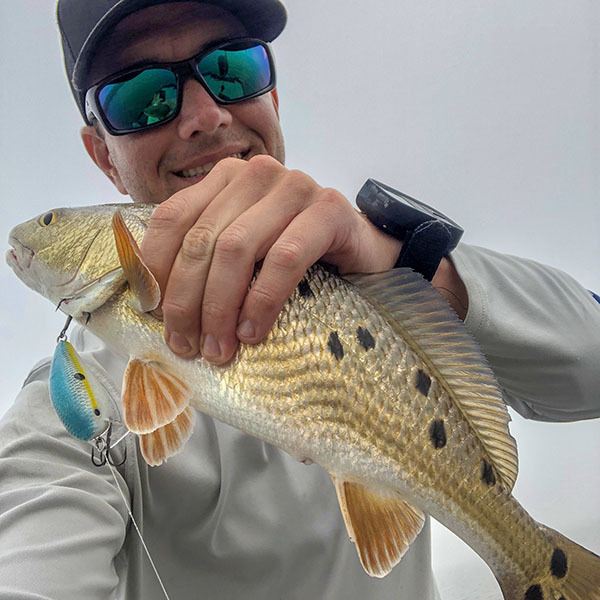
Some have been caught bearing dots along their back like a speckled trout.
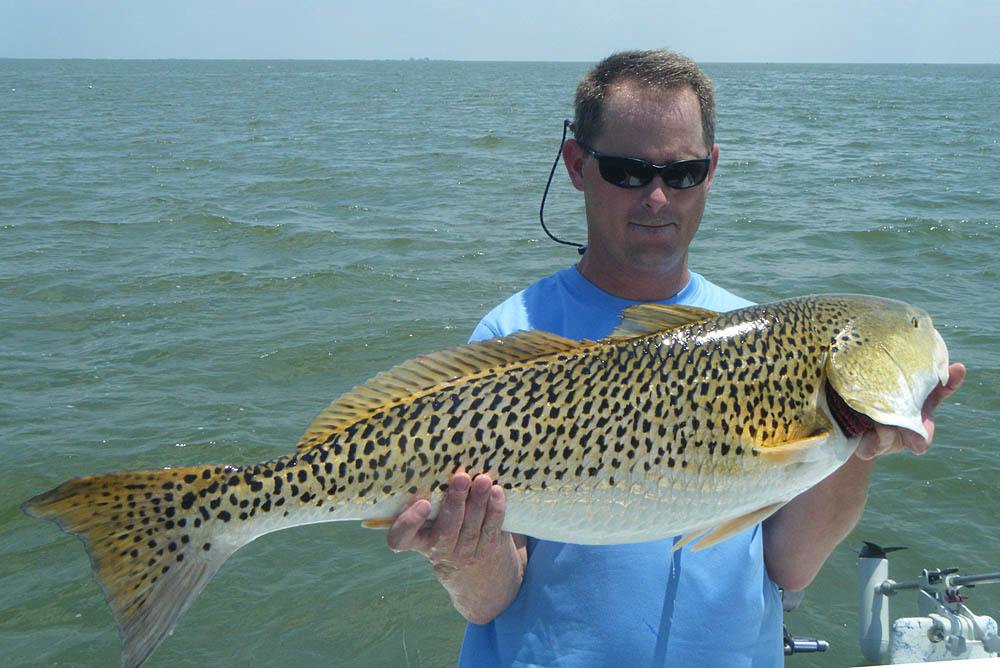
Redfish Description
Redfish and speckled trout have a lot in common:
- they are both drum (yeah, technically a speckled trout is not a trout, they are a drum)
- they both school
- they both spawn en masse
- they both can withstand varying salinities (redfish do much better with this)
There are also some striking differences:
- redfish are much stronger
- redfish grow way bigger
- redfish are tougher
- redfish don’t become sexually mature until about 27″ (a trout is closer to 8-10″)
Redfish are the big brawny cousin of speckled trout.
They have tougher scales that are as large and thick as your thumbnail, as well as thicker gill plates that allow them to tolerate dirty water and they can live in completely fresh water.
How big do redfish get?
Redfish can get pretty big, over 50″ in length.
16 inches is the minimum total length to keep a redfish. Five fish per person is the daily bag limit with not more than one exceeding 27 inches.
Always check with the Louisiana Department of Wildlife and Fisheries website to ensure you are in within the legal limits!
What's the Louisiana state record redfish?
The Louisiana state record redfish was caught in June of 1992 by David Weber. The monster redfish weighed 61 pounds.
How big is the world record redfish?
The world record redfish was caught in November 1984 in Hatteras, North Carolina by David Weber.
The redfish weighed 94 pounds and 2 ounces.
How fast do they grow?
How fast they grow really depends on the environment, to include water temperature, available forage and how much energy must be expended to get food.
The fattest of red drum can be found in Louisiana, where the tidal swings are low and there's plenty of shrimp, crab and more for redfish to gorge on.
Tagged Fish & Recapture Reports
These reports reveal how fast redfish can grow:
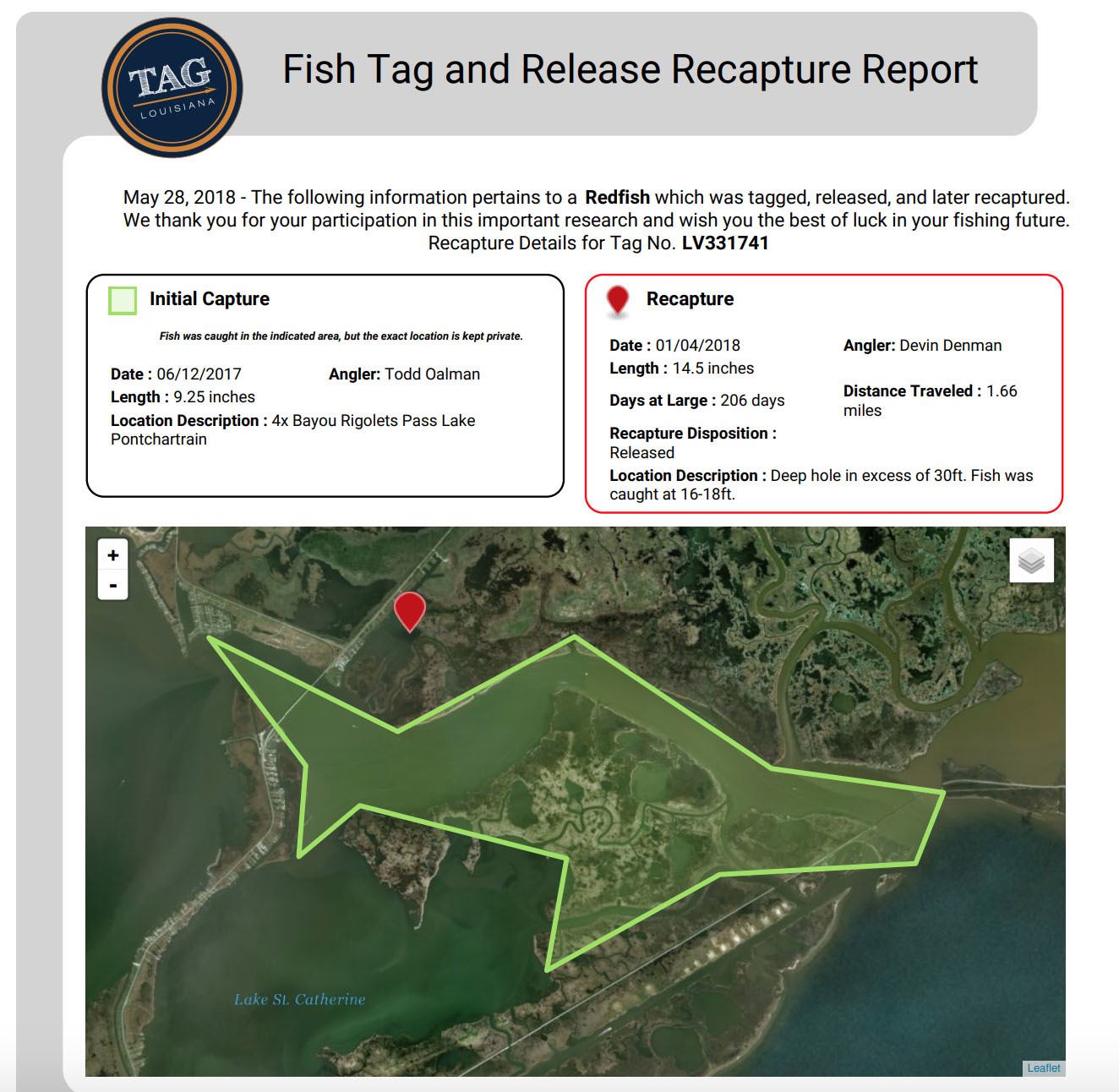
As you can see in the recapture report above, the fish was initially caught on June 12th, 2017 and measured 9.25 inches.
We caught him again on January 4th, 2018, measuring 14.5 inches.
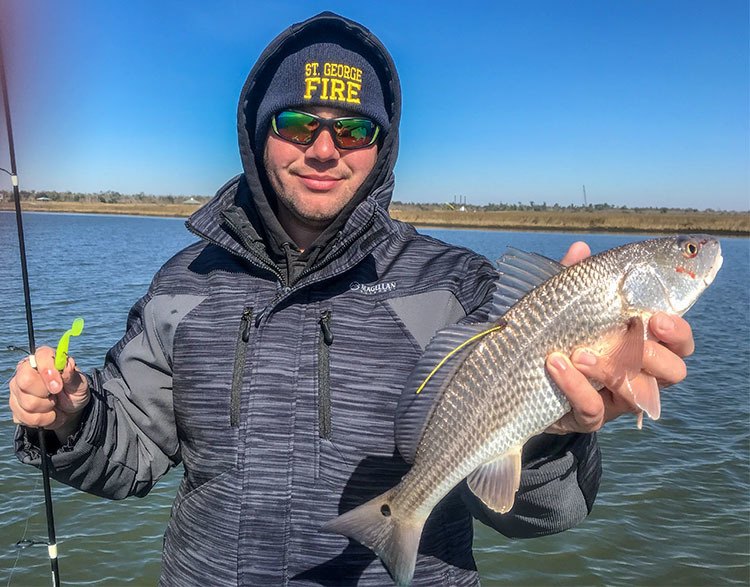
Of course, assuming these numbers are accurate, that redfish was no slouch, growing over five inches in 206 days.
Which isn't surprising when you think about it, because at that length they're still very much adolescents, and young fish always grow faster than older fish.
This is to reach maturity more quickly and become bigger so as to increase their chances of survival.
So what about older redfish? Keep reading!
How old do redfish get?
This bullred from South Carolina gives us a good idea.
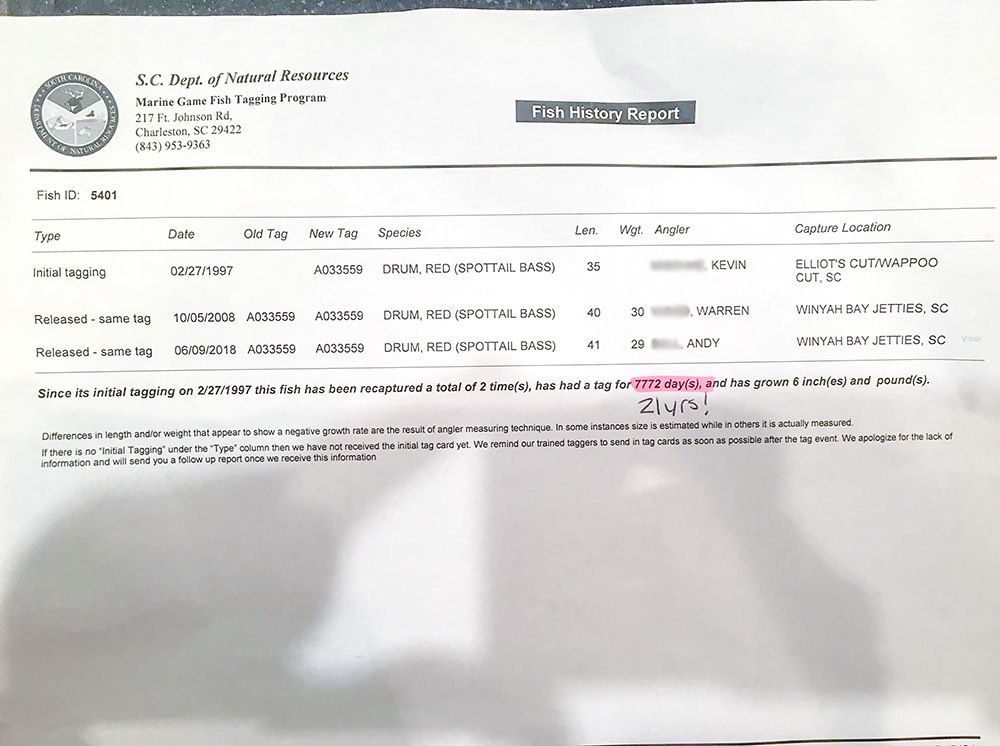
This ancient redfish was tagged on February 27th, 1997.
Compared to what we're tagging today, that's ancient history.
At the time he measured 35 inches in length, and kept swimming for over eleven years before being caught again.
Then he swam for almost another ten before being recaptured a second time.
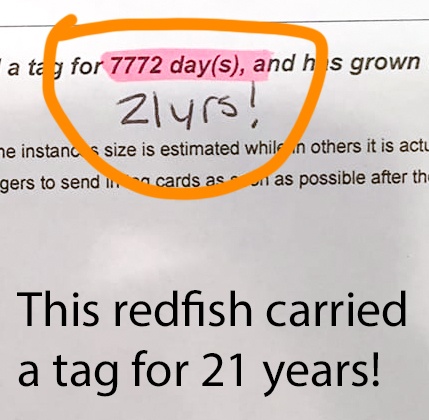
So how old is this redfish?
It's hard to know for sure, not without checking an otolith from its head (requiring its death).
But we know that this month, here and now in 2019, if this redfish is still swimming, he has been doing so for 22 years with a tag in his back.
Unreal.
Anyways, it's difficult to know exactly how old redfish are because they grow at different rates, but if I had to guess how old this one is, I'd say he is probably knocking on 30 to 35 years of age.
How long do redfish live?
According to the Atlantic States Marine Fisheries Commission, redfish can live up to sixty years of age.
Range & Habitat
Redfish are found in the freshest of ponds and in the saltiest of bays.
They are found offshore next to snapper and hammerhead sharks and they are found deep inside the freshwater marsh next to bluegill and bullhead carp.
In fact, red drum don’t need saltwater to survive. They only need a specific calcium level to be present in the water.
Freshwater lakes in the Carolinas and Texas have been stocked with redfish!
(NOTE: Redfish cannot spawn in freshwater, so those lakes must be restocked from time to time if they wish to keep a healthy population.)
Red Drum Life Cycle
The life cycle of redfish is similar to that of speckled trout.
- They spawn outside of the marsh in deep passes
- They move in huge schools (but not always)
- they begin life as tiny eggs inside the marsh
You don’t have to look very far to see videos of these bull redfish (virtually all mature redfish are bulls) running amok in various estuaries across the Gulf Coast.
These big bulls are congregating in salty water during the spawn, where they eat and spawn en masse.
They form large schools where eggs are released into a strong current and males fertilize them.
Seasonal Patterns of Red Drum
Talking about the seasonal patterns of red drum is somewhat of a moot point.
They’re not like speckled trout in the respect that their bio mass shifts from one side of the estuary to the other between winter and summer.
The bulls certainly do, but the juvenile slot reds are in the marsh year round and their patterns are fairly predictable.
Just as a reminder, redfish under 27 inches in length are considered to be juveniles.
The big bull reds move outside with the spawn and some of them stay “outside” permanently, in waters that are not considered inshore but offshore.
However, it is common to catch a huge redfish very close to the dock.
But, there are key differences in redfish behavior for each season, so let's go over that.
Summer
Red drum are easily had during the summer. They can be caught in near-freshwater and offshore in very salty water.
Because they slow down when they get too hot, they tend to eat first thing in the morning. After that they become inactive and rest.
Keep in mind that a cloudy day can keep water temps down a degree or two and that makes all the difference for redfish.
They will keep feeding so long as it is not too hot. Thunderstorms can knock down water temps with their blasts of cool air and shade.
Fall
The best redfishing of the year is found in the fall time. It should come as no surprise that redfish championships are held during the fall in October.
In fact, the redfishing can be so good in October that it is referred to as “Red October”, a play on words to the 1990 movie “The Hunt for Red October”.
In the fall redfish know winter is coming. They are fattening up on the shrimp leaving the marsh, as well as pogies, mullet, crab and pretty much anything they can fit in their mouth.
Don’t be surprised, but I have cleaned redfish with mice in their stomach!
Winter
Winter time is still a great time to hammer down on redfish, but only if you are willing to brave the cold.
As cold fronts blast across Louisiana they will push water out of the marsh, draining shallow water ponds that redfish like to feed in.
When this happens redfish will be found in the next deepest water.
If the water is so low it is not touching grass on the shoreline, then chances are reds are in the middle of the pond.
The lower the water gets, the better the redfishing will be. More of them will be packed into less water.
So if the water is really low you can expect redfish to drain into main arteries of water, like big bayous.
When this happens, it can be referred to as a "redfish jubilee" because the action is so good.
Throwing dead shrimp on the bottom is a guaranteed way to limit out once these fish are located.
So think of the marsh as being a series of levels, one higher than the other.
As the water gets higher, redfish will go up a level.
As the water gets lower, redfish will go down a level.
Spring
In spring the water temperature warms up and water levels rise as winds start to blow more from the south and east than the north and west.
Redfish are found in shallow ponds again and can be easily caught along shorelines.
Water clarity improves and aquatic grass begins growing back. Redfish are eating just like they do the rest of the year.
Spring is a good time to catch reds and when most redfish tournament trails begin.
Redfish Feeding Habits
Redfish do like tidal movement like speckled trout, but are best known for adhering to cover/structure.
Realize this and you will smash redfish on your fishing trips. Ignore it and you will come back to the dock without much to show.
Cover & Structure
These are terms used interchangeably (and sometimes incorrectly) through out the inshore fishing world.
You should use them as defined by the In-Fisherman Critical Concepts series of books (great reads by the way):
Structure is the shape of a body of water and the bottom of it. A pond is structured much differently from that of a bayou.
Cover refers to any object on structure such as grass mats, fallen trees, natural gas platforms, etc.
Why does this matter to redfish?
As stated before, redfish adhere to cover like a grassy shoreline or a grass mat.
If they’re not right up against it, they are going to be close to it. Also, unlike speckled trout, redfish readily swim in shallow water.
They are caught in water so shallow their backs are sticking out! But, that doesn’t mean they are always in super-shallow water.
Anglers tend to be most successful targeting redfish in two to four feet of water, so there is plenty of room to float a boat!
Anyways, knowing that redfish like shallow water and cover means they are going to be pretty predictable. This makes them easy to locate, close with and catch!
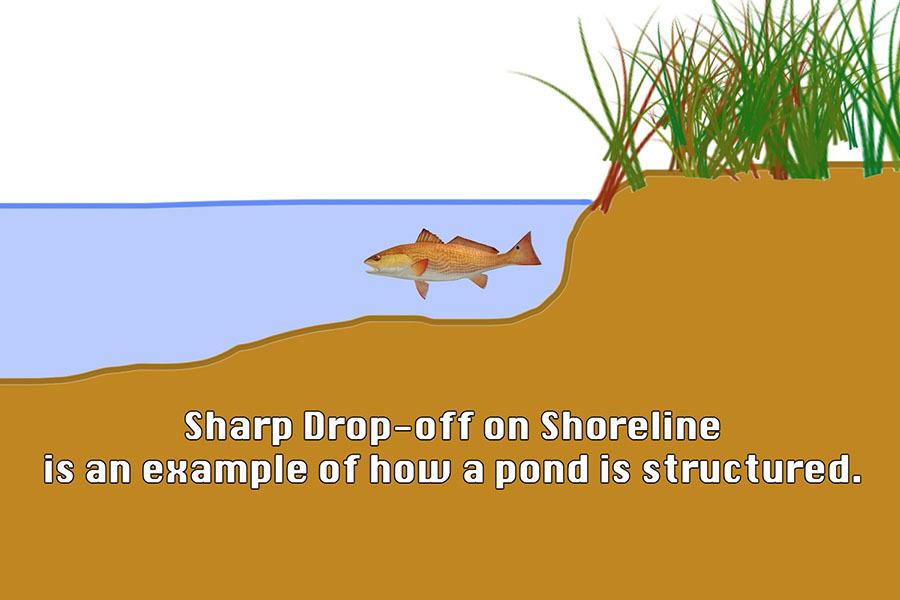
Note: These doodles are here to help you understand the concept of structure, and what it really means in reference to how bodies of water are shaped three-dimensionally.
Sure, they’re totally 3rd grade, but help you get “your head in the water” and start seeing things from the redfish’s perspective.
A sloped shoreline may have redfish yards off of it, instead of right against the shoreline, whereas a sharp drop-off shoreline will have reds right against the shoreline.
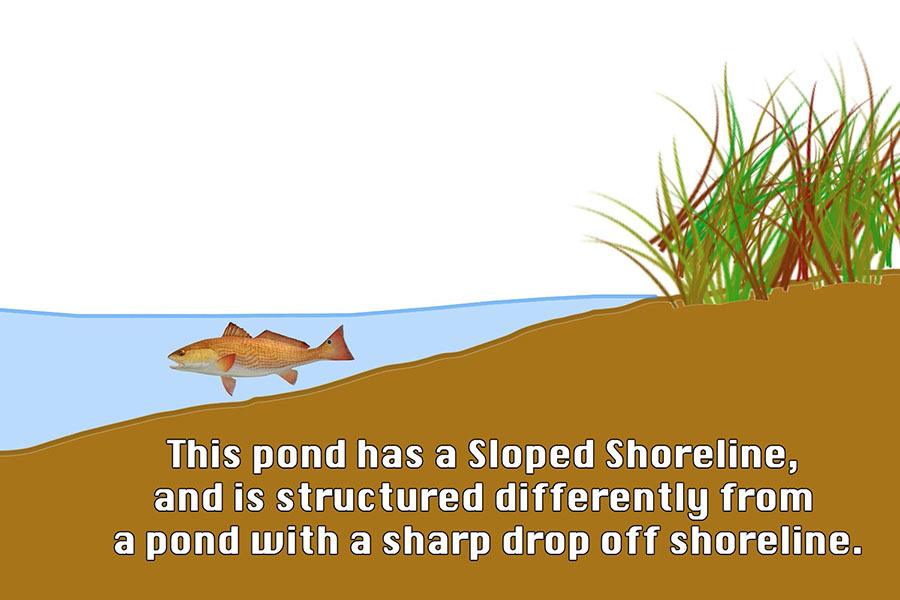
Patrol Heavy Species
Redfish love to patrol cover. If they don’t have cover, they are almost always cruising the shoreline. Sometimes you can see them in the water, like in this picture below.
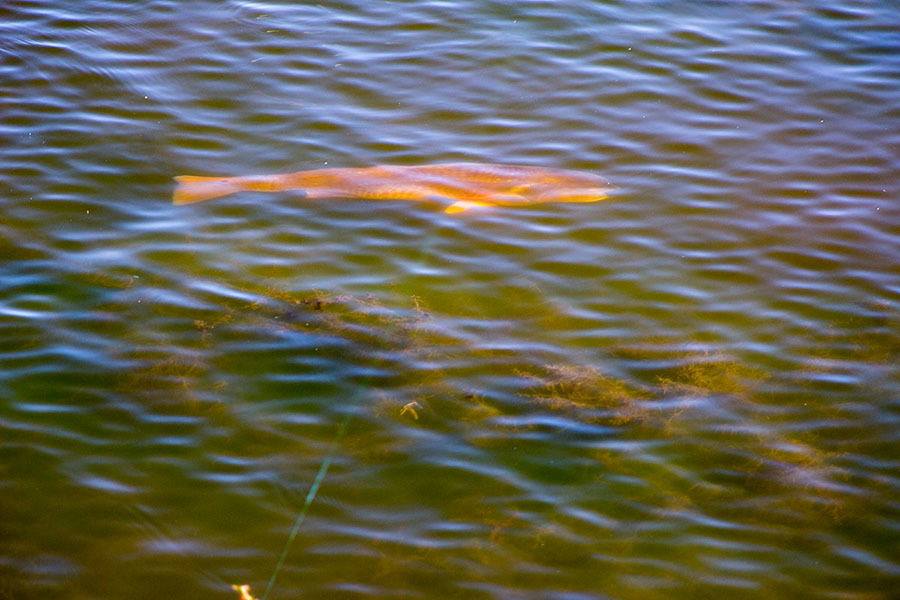
And other times they are detected by water pushing around them.
This is described as a “push”.
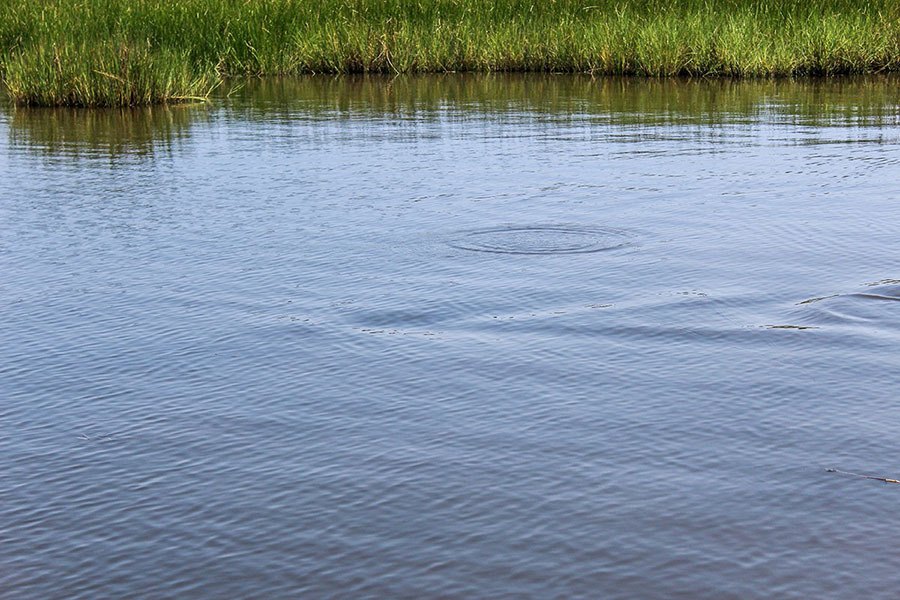
Redfish are easily found in shallow water around cover, so be sure to remember that.
Matted aquatic grass, also known as grass mats, is a surefire sign that redfish are around.
If there is no aquatic grass, then it’s strongly recommended you focus on the shoreline.
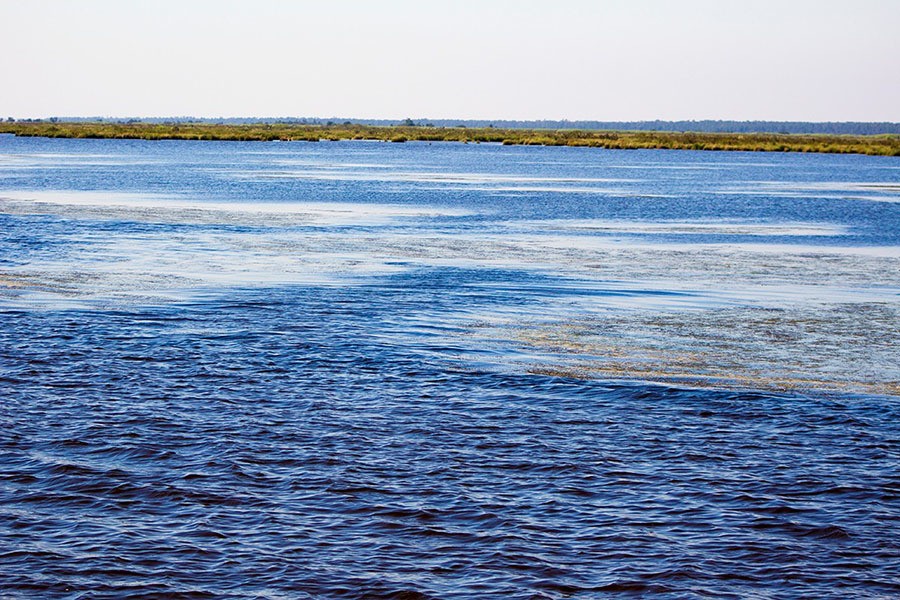
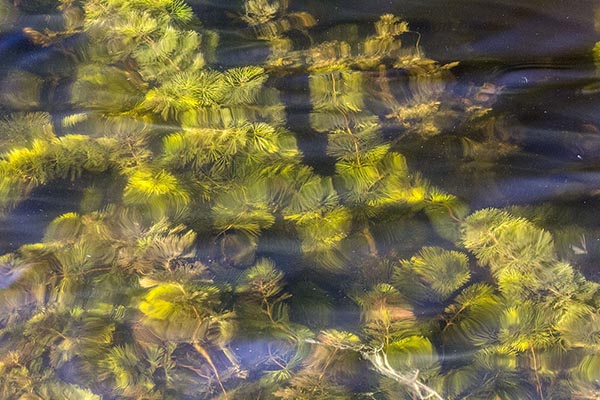
How do redfish eat?
Redfish do school together in large numbers, but not often. You are more likely to see them traveling by themselves, in pairs or smaller schools of four to ten.
Sometimes the schools are broken up due to fishing pressure, bait being scattered or boat traffic.
Redfish prefer to patrol the edge of cover looking for bait to eat. Very rarely do you see them in the open part of a pond far away from cover.
It’s also common for redfish to dig through the mud, looking for anything to eat like crabs, eels or shrimp.
When they do this their tail will stick out of the water and this is the iconic “tailing redfish” that makes for awesome fishing trips.
What do redfish eat?
Whatever fits in their mouth.
Remember that redfish are very rugged compared to other fish like speckled trout. They will nose into cover to get their food.
Redfish love eating crab. They can successfully eat crab because their mouths are tough like leather and they have ultra-strong crushers in the back.
Redfish eat voraciously. It has happened on my boat that a redfish hit two separate rods and was reeled in by two separate anglers!
They will eat the biggest thing that can fit in their stomach and then pack as much dessert on top of it as possible. Just look at the belly on this redfish:
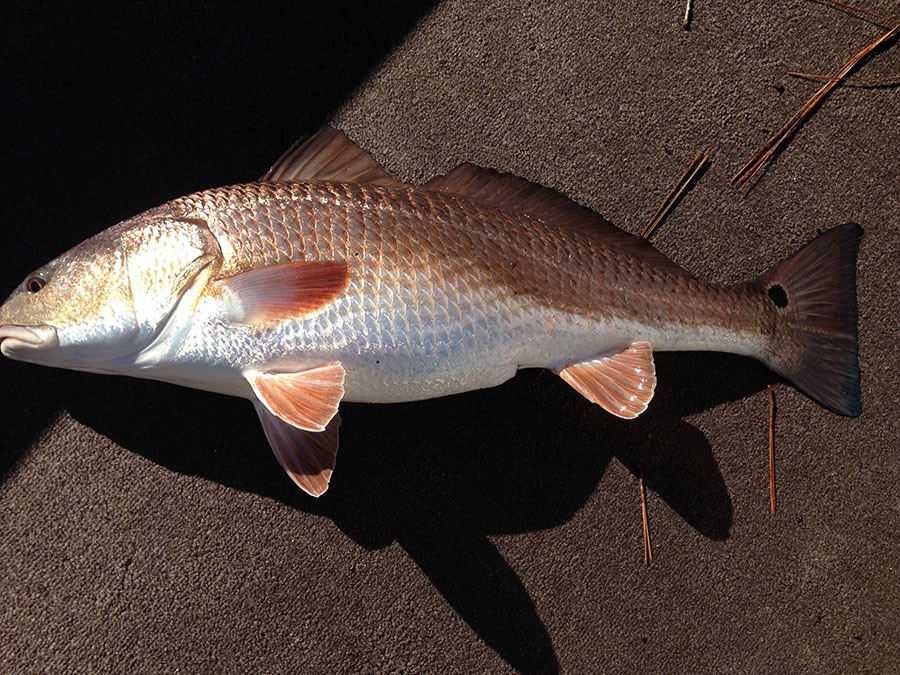
Why redfish are perfect for sight fishing:
Redfish are perfect for sight fishing for a variety of reasons:
- They are in the marsh year round.
- They are easy to see underwater.
- They are predictable.
Being in the marsh year round is key. Understand that speckled trout leave the marsh in the summertime for their spawn, making them accessible only on clear-weather days for people with big bay boats.
But redfish? You can sight fish them year-round in a beat-up flat boat!

Hey Charles, that’s a great question.
I guess it depends on the bow fishermen and what they are shooting.
I can tell you that anywhere they set up shop, the redfish action seems to decline.
While I do think the Freshening had an impact on redfish, over-harvesting them could certainly reduce their numbers.
Are the redfish and other species at rest in the marsh ponds at night? I’ve noticed a big decline of smaller slot reds since the night time bow fishing has become popular. Used to catch plenty slot reds and now we’re lucky to get a couple from the same ponds. There are a few bow fishing outfits that moved into the areas we fish in Cocodrie.
Eddie, I was born in Bonifay and schooled in Panama City so I hae fished West Bay for reds. Find a bank with grass and look for water movement along the edge. Use a loud popping cork with live shrimp near the grass.
However your best bet is to go to Shell Beach, Louisiana and fish out of Campo’s Marina esp in October. Got my days limit of 5 within one hour and less than a mile from the marina.
Thank you for the great article.
I’m fishing in Brevard County, Florida (Central Florida). We enjoy big reds in October in the Banana River. When the first cold fronts come down (50’s) the large Reds (35″-50″) disappear (generally November). I’m not sure if they leave our area and return to the ocean but it’s hot and heavy one moment and then they’re gone. I’d like to keep catching them but don’t understand what’s happening. Happens every year. We usually chunk mullet and ladyfish and use circle hooks so we lip hook them for release. Your article suggests that cold weather doesn’t affect them. Blessings
This was an awesome write-up. I live on the Alaqua creek, about a mile from Alaqua bay which is on the eastern part of Choctawhatchee bay in Freeport Florida. I was trying to determine if Reds could be had that far inshore but I think you answered my question. My dock sits on 12′ of water with a current, with a drop-off 6′ out thats unimaginably deep. Plus, I never see their favorite food source other than eel. My best bet, based on your info is to troll the most shallow banks of the Alaqua bay around the creek’s mouth where it’s grassy and where small mullet tend to jump. Really appreciate this!!
Good luck, and be sure to check LAFB Inshore for the latest fishing reports.
https://www.lafishblog.com/louisiana-fishing-reports/
Tight lines!
Just got an 18ft CC to take my boys out around LaFitte, LA. I am a novice fisherman, but love the Reds. Easy and always fun. Thanks for the great info and tips. We are sure to use your guidance.
-John B. Shreveport, LA
Glad you liked it. Thanks for reading!
Awesome write up, thx